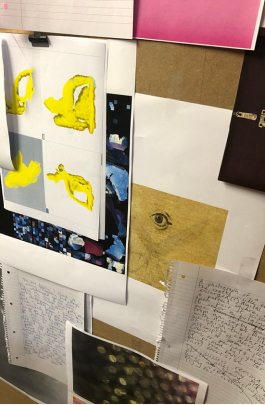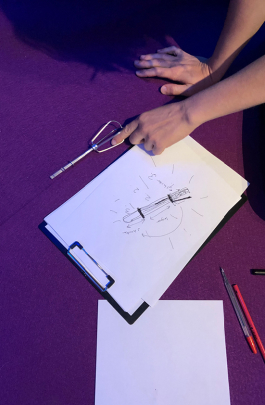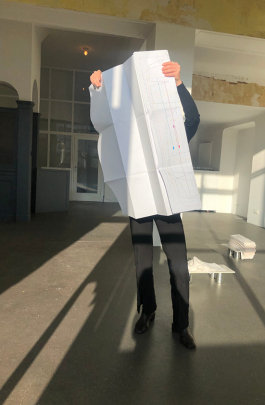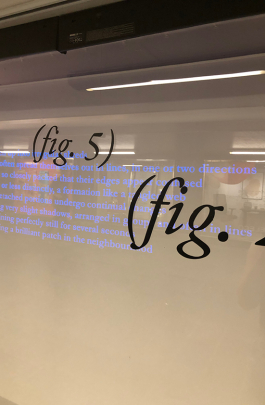Alina Rentsch (b. 1992) lives and works in Berlin and is mainly working with language, communication processes, structures of response, and language’s relation to image and body. Interested in questions surrounding the distribution of text and the role of the reader, her artistic projects often materialize as spatial text installations or as printed matter. She holds a BFA from Weißensee Academy of Art, Berlin and graduated with a MFA from Konstfack, Stockholm in 2022. She has participated in exhibitions, programs, and workshops at Petrine, Paris (2024), Vapaan Taiteen Tila (2023), Ehemalige Postsparkasse, Angewandte Interdisciplinary Lab, Vienna; Index–The Swedish Contemporary Art Foundation, Stockholm; B7L9 Art Station, Kamel Lazaar Foundation, Tunis; Magito/Suvilahti, Helsinki; Studio Giardini, IASPIS program during the 59th Venice Biennale, Venice; Nordiska Konstförbundet (NKF), Stockholm (all 2022); Salon am Moritzplatz, Berlin; Kl.09, Stockholm (all 2021); and Konsthall C, Stockholm (2019).
Also a hair seems to have crept in
Installation, various materials
The exhibition comprises new works that take the gallery space itself as subject, exploring the relationship between the objects and their physical environment. Over the course of the past year the gallery space was documented with a book scanner, a technology that suggests automatic generation of objective reproduction. The scans however resulted in a contrary image: bearing traces of glitches, faults, disturbances, things that are fragile, changeable, manipulable. Embracing these traces opens up another methodology of creation, something that cannot be produced again and/or intentionally. A sociological approach to space puts forth that it is neither object or vessel, but rather a means of production. Enacted through social processes and conventions of use, they define the modes of such production. If before the space appeared empty, the doubling, reproducing, and fragmenting turns this perceived emptiness into objects, rendering what is on view into goods, setting off a continuous process of transmutations in a commercial setting.
To purchase a copy of the publication accompanying the exhibition please contact the gallery at info@petrine.fr

























Great Weather
Sublimation print on textile (420 cm x 140 cm)
Since the renaissance, ceramic figurines have been used as decoration for ceremonial tables with the purpose of suggesting subjects of conversation to guests. Great Weather gathers these “conversation pieces” on a table, where the objects themselves enter into dialogue with each other. Taken out of their customary surroundings, the work questions their legibility today and proposes an alternative way of looking at these pieces, creating an environment conducive to exchange and conviviality, within a space that is less aligned with such qualities.














Talking in circles
Glossy vinyl foil installed on floor, dimensions variable
Talking in circles invites visitors to follow a series of colorful streams of words throughout the exhibition space. The meandering, site-specific chains of letters on the floor appear chaotic at first, but once the reader decides on a line to follow, the multifaceted patterns of idioms propose a rather unconventional navigation through the space. Within this performative encounter of the observers with the rhythmic wordings, the latter are transferred into a third dimension. The reading bodies themselves become an integral part of the installation, partly obscuring the letters with their presence, whilst simultaneously revealing them for distant observers.
A Printable Exhibition
Offset print on newsprint paper, edition of 100 copies
In collaboration with Sofia Priftis and Elina Birkehag
In the three-day workshop A Printable Exhibition at Index – The Swedish Contemporary Art Foundation in Stockholm, we worked on a publication that played with the idea to translate the materiality of artworks (three-dimensional, printed, ephemeral, etc.) into 2D-formats. Primarily this took form in pages of a zine that could later be torn out and re-exhibited in another context. The purpose of the workshop was to expand the borders of what printed matter – but also exhibition making in the most general sense – can be while revolving around concepts of circulation and distribution by making use of Index’s proximity to a post office.
Figuring Speech
Glossy vinyl film installed on floor, dimensions variable
Figuring Speech originates from the form and system of cutting patterns; templates from which the parts of a garment, so-called figures, are traced onto fabric before being cut out and assembled. Through rewriting the outlines of the figures with seemingly endless sentences of figures of speech, a configuration results. By using vinyl-letters to apply these sewing pattern shapes onto the floor of the exhibition space, the configuration is turned into a living map – the shapes become walkable guidelines, paths which aim to invite visitors to take detours through their reading, intuitively tracing and performing the spatial pattern.
Exercise in Style
Print on matte paper, 84 × 119 cm, edition of 100 copies
In tailoring, a cutting pattern is a template from which the parts of a garment are traced onto fabric before being cut out and assembled. Cutting pattern sheets are usually to be found as supplements in the back of tailoring magazines, folded into the size of an A4 and distributed in large numbers. A two-dimensional pattern representing a three-dimensional object, broken down into individual parts. A system of special contour lines, different types of lines, numbers and colours help tracing. In this project, the practical guidelines that are used to transfer shapes – the figures – taken in the literal sense, are turned into a web of text: replaced with different rhetorical patterns, figures of speech, the pattern lines are becoming word lines and result in an interplay of text and textile.
The Direction From Which The Clouds Come
Vinyl letters, UV-spray, UV-light, timer
In collaboration with Danae Valenza
Whenever one tries to look at clouds as things, one becomes aware of their dissolving, rapidly disappearing character. This ontological strangeness of the cloud as a veiled half-thing appears only fleetingly, yet is fixed in a molecular structure. Here, it is positioned as a tool for the observation and description of rhythmic formations in public spaces. In the 19th century, early scientific methods tried to classify, describe, and order these transient bodies, summarized in encyclopedias such as the International Cloud Atlas. By extracting poetic moments of this instructive text, alternative meanings are created, becoming reflective of the site itself. The gesture is amplified with the use of ultraviolet light, brought underground. Natural phenomena are superimposed onto the syncopation of collective space. In this context the cloud is a metaphor for an aesthetic of fleetingness in the tension between appearance and disappearance – infrastructures that are remarkably similar to the continuous movements within a public passageway.
Scroll to top
© 2024 All Rights Reserved.
Alina Rentsch (b. 1992) lives and works in Berlin and is mainly working with language, communication processes, structures of response, and language’s relation to image and body. Interested in questions surrounding the distribution of text and the role of the reader, her artistic projects often materialize as spatial text installations or as printed matter. She holds a BFA from Weißensee Academy of Art, Berlin and graduated with a MFA from Konstfack, Stockholm in 2022. She has participated in exhibitions, programs, and workshops at Petrine, Paris (2024), Vapaan Taiteen Tila (2023), Ehemalige Postsparkasse, Angewandte Interdisciplinary Lab, Vienna; Index–The Swedish Contemporary Art Foundation, Stockholm; B7L9 Art Station, Kamel Lazaar Foundation, Tunis; Magito/Suvilahti, Helsinki; Studio Giardini, IASPIS program during the 59th Venice Biennale, Venice; Nordiska Konstförbundet (NKF), Stockholm (all 2022); Salon am Moritzplatz, Berlin; Kl.09, Stockholm (all 2021); and Konsthall C, Stockholm (2019).
Also a hair seems to have crept in
Installation, various materials
The exhibition comprises new works that take the gallery space itself as subject, exploring the relationship between the objects and their physical environment. Over the course of the past year the gallery space was documented with a book scanner, a technology that suggests automatic generation of objective reproduction. The scans however resulted in a contrary image: bearing traces of glitches, faults, disturbances, things that are fragile, changeable, manipulable. Embracing these traces opens up another methodology of creation, something that cannot be produced again and/or intentionally. A sociological approach to space puts forth that it is neither object or vessel, but rather a means of production. Enacted through social processes and conventions of use, they define the modes of such production. If before the space appeared empty, the doubling, reproducing, and fragmenting turns this perceived emptiness into objects, rendering what is on view into goods, setting off a continuous process of transmutations in a commercial setting.
To purchase a copy of the publication accompanying the exhibition please contact the gallery at info@petrine.fr






















Great Weather
Sublimation print on textile (420 cm x 140 cm)
Since the renaissance, ceramic figurines have been used as decoration for ceremonial tables with the purpose of suggesting subjects of conversation to guests. Great Weather gathers these “conversation pieces” on a table, where the objects themselves enter into dialogue with each other. Taken out of their customary surroundings, the work questions their legibility today and proposes an alternative way of looking at these pieces, creating an environment conducive to exchange and conviviality, within a space that is less aligned with such qualities.










Talking in circles
Glossy vinyl foil installed on floor, dimensions variable
Talking in circles invites visitors to follow a series of colorful streams of words throughout the exhibition space. The meandering, site-specific chains of letters on the floor appear chaotic at first, but once the reader decides on a line to follow, the multifaceted patterns of idioms propose a rather unconventional navigation through the space. Within this performative encounter of the observers with the rhythmic wordings, the latter are transferred into a third dimension. The reading bodies themselves become an integral part of the installation, partly obscuring the letters with their presence, whilst simultaneously revealing them for distant observers.
A Printable Exhibition
Offset print on newsprint paper, edition of 100 copies
In collaboration with Sofia Priftis and Elina Birkehag
In the three-day workshop A Printable Exhibition at Index – The Swedish Contemporary Art Foundation in Stockholm, we worked on a publication that played with the idea to translate the materiality of artworks (three-dimensional, printed, ephemeral, etc.) into 2D-formats. Primarily this took form in pages of a zine that could later be torn out and re-exhibited in another context. The purpose of the workshop was to expand the borders of what printed matter – but also exhibition making in the most general sense – can be while revolving around concepts of circulation and distribution by making use of Index’s proximity to a post office.
Figuring Speech
Glossy vinyl film installed on floor, dimensions variable
Figuring Speech originates from the form and system of cutting patterns; templates from which the parts of a garment, so-called figures, are traced onto fabric before being cut out and assembled. Through rewriting the outlines of the figures with seemingly endless sentences of figures of speech, a configuration results. By using vinyl-letters to apply these sewing pattern shapes onto the floor of the exhibition space, the configuration is turned into a living map – the shapes become walkable guidelines, paths which aim to invite visitors to take detours through their reading, intuitively tracing and performing the spatial pattern.
Exercise in Style
Print on matte paper, 84 × 119 cm, edition of 100 copies
In tailoring, a cutting pattern is a template from which the parts of a garment are traced onto fabric before being cut out and assembled. Cutting pattern sheets are usually to be found as supplements in the back of tailoring magazines, folded into the size of an A4 and distributed in large numbers. A two-dimensional pattern representing a three-dimensional object, broken down into individual parts. A system of special contour lines, different types of lines, numbers and colours help tracing. In this project, the practical guidelines that are used to transfer shapes – the figures – taken in the literal sense, are turned into a web of text: replaced with different rhetorical patterns, figures of speech, the pattern lines are becoming word lines and result in an interplay of text and textile.
The Direction From Which The Clouds Come
Vinyl letters, UV-spray, UV-light, timer
In collaboration with Danae Valenza
Whenever one tries to look at clouds as things, one becomes aware of their dissolving, rapidly disappearing character. This ontological strangeness of the cloud as a veiled half-thing appears only fleetingly, yet is fixed in a molecular structure. Here, it is positioned as a tool for the observation and description of rhythmic formations in public spaces. In the 19th century, early scientific methods tried to classify, describe, and order these transient bodies, summarized in encyclopedias such as the International Cloud Atlas. By extracting poetic moments of this instructive text, alternative meanings are created, becoming reflective of the site itself. The gesture is amplified with the use of ultraviolet light, brought underground. Natural phenomena are superimposed onto the syncopation of collective space. In this context the cloud is a metaphor for an aesthetic of fleetingness in the tension between appearance and disappearance – infrastructures that are remarkably similar to the continuous movements within a public passageway.
Scroll to top
© 2024 All Rights Reserved.


























































